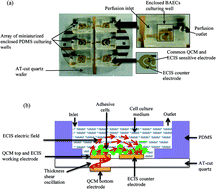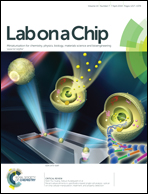A lab-on-chip cell-based biosensor for label-free sensing of water toxicants
Abstract
This paper presents a lab-on-chip biosensor containing an enclosed fluidic cell culturing well seeded with live cells for rapid screening of toxicants in drinking water. The sensor is based on the innovative placement of the working electrode for the electrical cell–substrate impedance sensing (ECIS) technique as the top electrode of a quartz crystal microbalance (QCM) resonator. Cell damage induced by toxic water will cause a decrease in impedance, as well as an increase in the resonant frequency. For water toxicity tests, the biosensor's unique capabilities of performing two complementary measurements simultaneously (impedance and mass-sensing) will increase the accuracy of detection while decreasing the false-positive rate. Bovine aortic endothelial cells (BAECs) were used as toxicity sensing cells. The effects of the toxicants, ammonia, nicotine and aldicarb, on cells were monitored with both the QCM and the ECIS technique. The lab-on-chip was demonstrated to be sensitive to low concentrations of toxicants. The responses of BAECs to toxic samples occurred during the initial 5 to 20 minutes depending on the type of chemical and concentrations. Testing the multiparameter biosensor with aldicarb also demonstrated the hypothesis that using two different sensors to monitor the same cell monolayer provides cross validation and increases the accuracy of detection. For low concentrations of aldicarb, the variations in impedance measurements are insignificant in comparison with the shifts of resonant frequency monitored using the QCM resonator. A highly linear correlation between signal shifts and chemical concentrations was demonstrated for each toxicant.

- This article is part of the themed collection: Microtechnologies in Medicine and Biology (MMB 2013)

 Please wait while we load your content...
Please wait while we load your content...